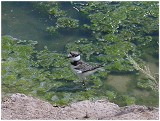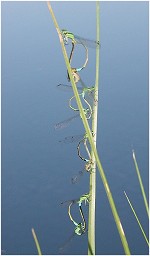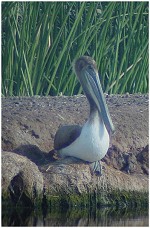New River Wetlands Project
As we continue to monitor these
two experimental ponds, we'll be updating the bird list and adding links
to this page.
102+ species
since 2001 (partial list follows at end page)

Click on
thumbnail pictures for full-sized shots.
October 2001
by Bob Miller
The New River
has long been considered one of the most polluted waterways in the
United States. Originating in Mexico, and flowing through the Imperial
Valley, it winds its way north about 67 river miles from the border to
the Salton Sea. The river carries agricultural runoff, sewage, and
industrial runoff from both sides of the border. Most of the sewage and
industrial runoff is treated. Proposed regulations will set total
maximum daily loads (TMDL) of silt and nutrients that are allowable in
agricultural runoff and in the rivers. Nutrient loads flowing in from
the river are thought to be a major contributor to the worsening health
of the Salton Sea ecosystem.
Leon Lesicka,
of Desert Wildlife Unlimited, currently heads The Citizen’s
Congressional Task Force on the New River, which was formed in 1997 with
the help of Congressman Duncan Hunter, to improve the quality of the
river water and wildlife habitat. Working with the Imperial Irrigation
District and Bureau of Reclamation, along with numerous other agencies,
they have brought the pilot project well into its second year. Initial
construction began in late Spring of 2000 and vegetation was planted by
mid summer.
The New River
is mostly bordered by non-native invasive species such as tamarisk and
phragmites, and provides little value to wildlife. This new project is
already adding tremendous habitat for wildlife as well as doing a
remarkable job of cleaning the waters of the river through the use of
nature itself. The initial pilot project consists of two sites. The
Imperial site is 68 acres and 1.5 miles long. The Brawley site is 7
acres in size. The Imperial site receives its water from the Rice Drain
and is entirely agricultural runoff. The Brawley site pumps water
directly from the New River. The water first flows into the large
settling ponds to settle out the heavier silts and from there flows into
a series of smaller ponds planted with native bulrushes and sedges. The
vegetation and ponds are laid out so the water must wind its way in a
zigzag pattern the length of the site. Initial testing of water in and
out of the systems has shown a decrease of as much as 97% in total
suspended solids and an increase of up to 83% in dissolved oxygen. If
proven successful, the wetlands will be expanded to cover most of the
river bottom areas of the New and Alamo rivers with about 37 new sites
being considered already.
Henry
Detwiler and I are conducting the avian and wildlife surveys for the
project. We began our surveys in March of this year, doing five visits
to each site, per quarter. To date we have recorded just over 100
species and confirmed successful nesting of about 15, with numerous
probable breeders. The large settling ponds attract grebes, herons,
cormorants, terns, shorebirds, waterfowl and pelicans. The bulrushes and
sedges are maturing rapidly. American Bittern has been recorded at the
Brawly site and Least Bittern at both sites. The Brawley site has a
power line passing nearby and a date grove on top of the hill which
attracts kingfishers, kingbirds, accipiters and the like. The Imperial
site has little in the way of trees but the few pockets of mesquite
along the hillside can be loaded with warblers, sparrows, towhee, etc.
Marsh Wren and Common Yellowthroat pretty much own the bulrushes
with Orange-crowned Warblers coming in big numbers during the fall.
Large flocks of blackbirds, ibis and egrets abound. Although they have
not been using the wetlands directly, Prairie and Peregrine Falcon have
been seen near the Imperial site recently. The fields just to the
South of Wienert Road hold some of the highest concentrations of
wintering Mountain Plover in the Imperial Valley.
These sites
will prove to be a regular stop on any birding trip to the Salton Sea.
Dragonflies. Nine species and counting!
|

Damselfly - Imperial Ponds
|

Yellow-headed Blackbird
Imperial Ponds
|

Horseback Riding - Brawley Ponds
|

Killdeer Chick - Brawley Ponds
|
|

Breeding Damselflies -
Imperial Ponds
|

Brown Pelican -
Imperial Ponds
|
DIRECTIONS
The Imperial
site is located west of Forester Road and on the south bank of the New
River. Coming from San Diego, go north on Forester Road from I-8. You
will go past Worthington Road and turn west on Wienert Road, which only
goes west. At about two miles a large deep drain canal will join you on
the left--this is the Rice Drain and it supplies the project. A little
further on the Rice Drain passes under Wienert and heads northwest. Turn
right on the first bank, there is a small sign hanging from a chain that
says “Granite”. Follow
the drain down into the site.
To reach the
Brawley site from the Imperial site, take Wienert back to Forester and
go north. Turn east on Keystone Road, which only goes to the right.
Keystone runs into Hwy 86, where you will turn left (go north) toward Brawley.
Turn left (west) on Legion Road, which is the first signal light a mile south of
Brawley. Follow Legion Road to the end of the pavement and continue
along the chain link fence on your left. You will pass through an open
gate and will come to an orange painted standpipe. The road down into
the wetlands is immediately on your right. You can get to an overlook of
the site if you continue to the date grove.
|